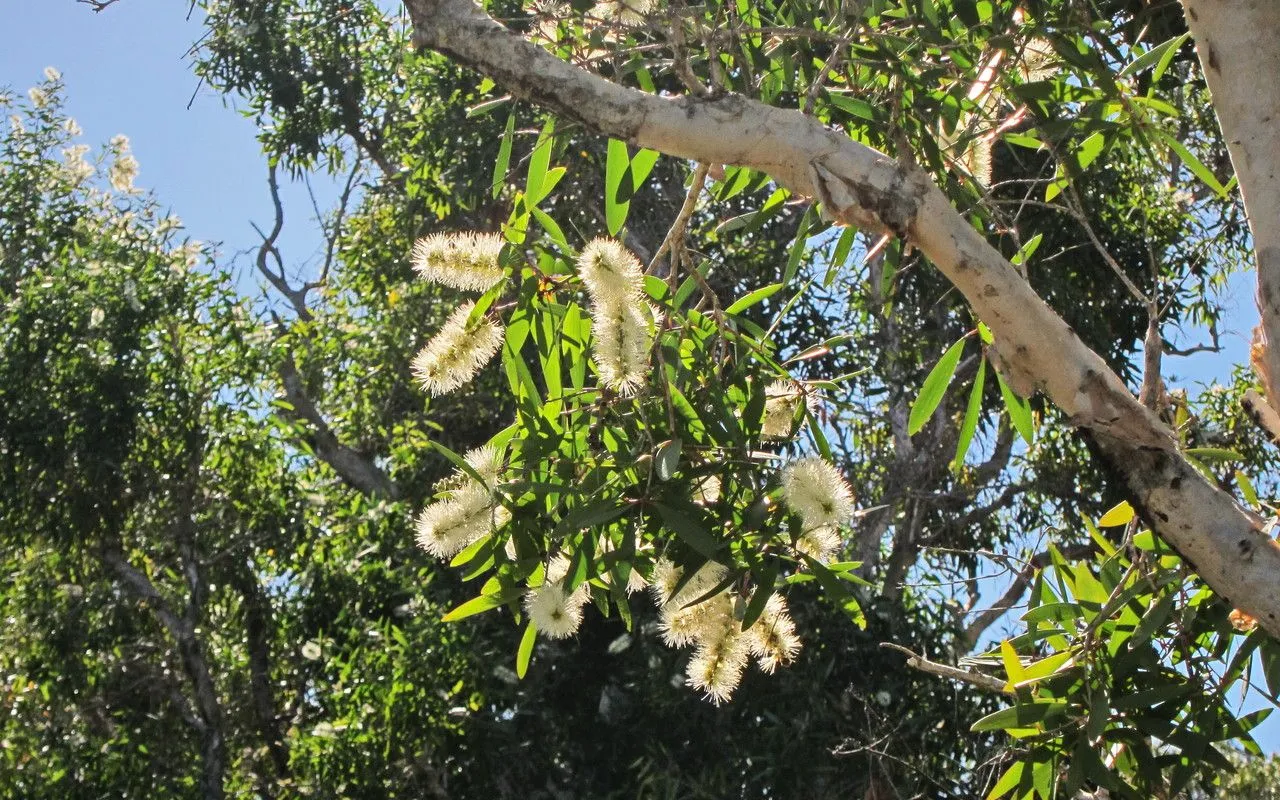
Author: (Cav.) S.T.Blake
Bibliography: Proc. Roy. Soc. Queensland 69: 76 (1958)
Year: 1958
Status: accepted
Rank: species
Genus: Melaleuca
Vegetable: Unknown
Observations: New Guinea, New Caledonia, E. Australia
The Punktree, scientifically recognized as Melaleuca quinquenervia, is a significant member of the Myrtaceae family. This resilient species was first described in 1958, as noted in the Proceedings of the Royal Society of Queensland, volume 69, page 76, and was authenticated by S.T. Blake.
Native to diverse regions such as New Guinea, New Caledonia, and the eastern regions of Australia, the Punktree is notable for its adaptability and robustness in various habitats. It is commonly found in swamps and along watercourses, where it plays a vital role in the local ecosystem.
The Punktree features distinctive papery bark, which peels in thin layers, giving rise to one of its colloquial names, the “Paperbark Tree.” This adaptation not only contributes to the tree’s unique appearance but also aids in its survival by providing insulation against fires, a common occurrence in its native regions.
Its leaves are simple, alternate, and characterized by numerous oil glands, which emit a pleasant aroma when crushed. These essential oils have been historically utilized for medicinal purposes, particularly by Indigenous Australians. The leaves are also notable for their five prominent veins, a trait referenced in its scientific name, with “quinquenervia” translating to “five-nerved.”
The Punktree blooms with cream-colored flowers that cluster on spikes, attracting a variety of pollinators, including bees and birds. These pollinators play a crucial part in the plant’s reproductive process, ensuring the continuation and spread of the species.
Melaleuca quinquenervia is more than just a botanical curiosity; it is an important ecological player. Its ability to thrive in waterlogged soils helps stabilize wetland areas and prevent erosion. Additionally, it provides habitat and food for a plethora of wildlife. However, in regions outside its native range, it has been noted for its invasive potential, indicating the need for careful management when introduced to new environments.
Understanding the Punktree’s characteristics and role in its ecosystem highlights not only its botanical interest but also its importance in environmental conservation efforts.
Eng: punktree, belbowrie, bottle brush tree, broadleaf paperbark, broadleaf teatree, cajeput tree, coastal teatree, five-vein paperbark, melaleuca, niaouli, paperbark, paperbark teatree, broad-leaved paperbark, paper bark, paper bark tea tree, white bottlebrush tree
Ind: kayu putih
Por: melaleuca
Fra: niaouli
En: Punktree, Belbowrie, Bottle brush tree, Broadleaf paperbark, Broadleaf teatree, Cajeput tree, Coastal teatree, Five-vein paperbark, Melaleuca, Niaouli, Paperbark, Paperbark teatree, Broad-leaved Paperbark, Paper Bark, Paper Bark Tea Tree, White Bottlebrush Tree, Paper bark tree, Punk tree, Paperbark tree
Fr: Niaouli
Id: Kayu putih
Pt: Melaleuca
Taken Nov 30, 2022 by anne amouroux (cc-by-sa)
Taken Jul 26, 2014 by Tela Botanica − Pierre Bonnet (cc-by-sa)
Taken Feb 18, 2022 by Ciro (cc-by-sa)
Taken Apr 7, 2016 by Hugo SANTACREU (cc-by-sa)
Taken Feb 21, 2022 by Boris Therock (cc-by-sa)
Taken Jun 11, 2019 by laurent verriez (cc-by-sa)
Taken May 5, 2021 by mehdi hassouni (cc-by-sa)
Taken Aug 24, 2019 by Valentin courteille (cc-by-sa)
Taken Feb 21, 2022 by Boris Therock (cc-by-sa)
Taken Feb 21, 2022 by Boris Therock (cc-by-sa)
Taken Jan 1, 1970 by Endemia – Bernard Suprin (cc-by-nc)
Taken Mar 17, 2016 by Endemia – Jean-Jacques Villegente (cc-by-nc)
Taken May 23, 2015 by Endemia – Benoît Henry (cc-by-nc)
Taken Jan 1, 1970 by Endemia – Jacques Bottet (cc-by-nc)
Taken Jul 4, 2022 by Amy A. (cc-by-sa)
Taken Dec 8, 2016 by Leiticia Dimba (cc-by-sa)
Taken May 11, 2016 by Hugo SANTACREU (cc-by-sa)
Taken Feb 21, 2022 by Boris Therock (cc-by-sa)
Taken Jun 5, 2018 by micka (cc-by-sa)
Taken Jun 14, 2014 by Richard Chesher (cc-by-sa)
Taken Sep 20, 2016 by Hugo SANTACREU (cc-by-sa)
Taken Sep 20, 2016 by Hugo SANTACREU (cc-by-sa)
Taken May 14, 2016 by Hugo SANTACREU (cc-by-sa)
Taken Oct 21, 2020 by Exposito Laure (cc-by-sa)
Taken Jul 23, 2022 by Ирина Пицунова (cc-by-sa)
Taken May 11, 2016 by Hugo SANTACREU (cc-by-sa)
Taken Jun 14, 2014 by Richard Chesher (cc-by-sa)
© copyright of the Board of Trustees of the Royal Botanic Gardens, Kew.
© copyright of the Board of Trustees of the Royal Botanic Gardens, Kew.
Family: Myrtaceae Author: (F.Muell.) K.D.Hill & L.A.S.Johnson Bibliography: Telopea 6: 402 (1995) Year: 1995 Status:…
Family: Rubiaceae Author: Pierre ex A.Froehner Bibliography: Notizbl. Bot. Gart. Berlin-Dahlem 1: 237 (1897) Year:…
Family: Sapindaceae Author: Koidz. Bibliography: J. Coll. Sci. Imp. Univ. Tokyo 32(1): 38 (1911) Year:…
Family: Asteraceae Author: A.Gray Bibliography: Pacif. Railr. Rep.: 107 (1857) Year: 1857 Status: accepted Rank:…
Family: Fabaceae Author: Medik. Bibliography: Vorles. Churpfälz. Phys.-Ökon. Ges. 2: 398 (1787) Year: 1787 Status:…
Family: Aspleniaceae Author: (Cav.) Alston Bibliography: Bull. Misc. Inform. Kew 1932: 309 (1932) Year: 1932…